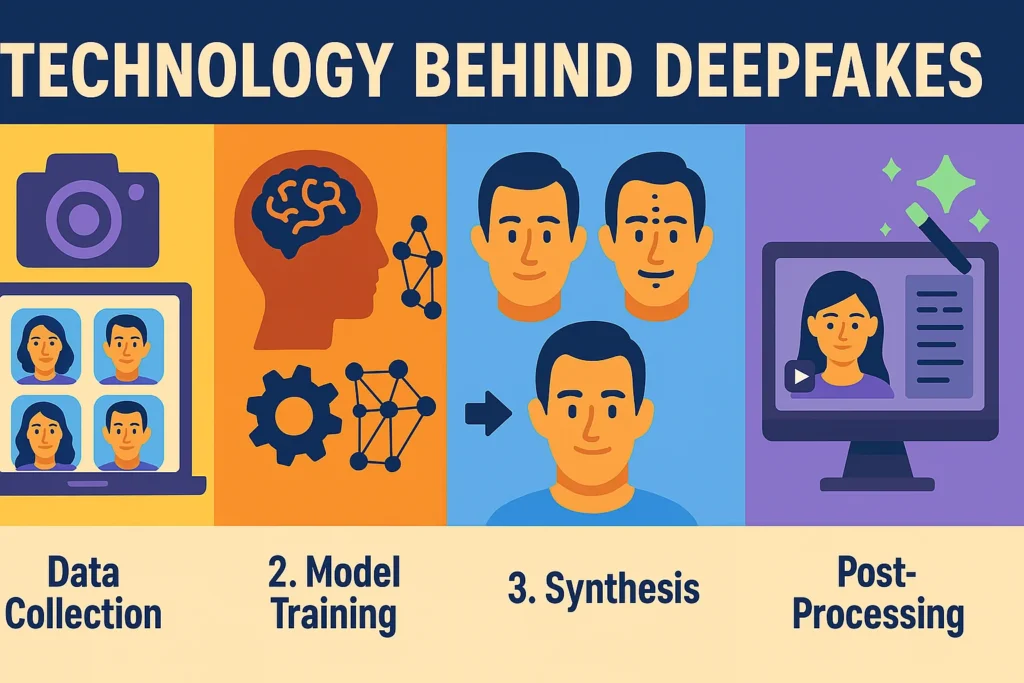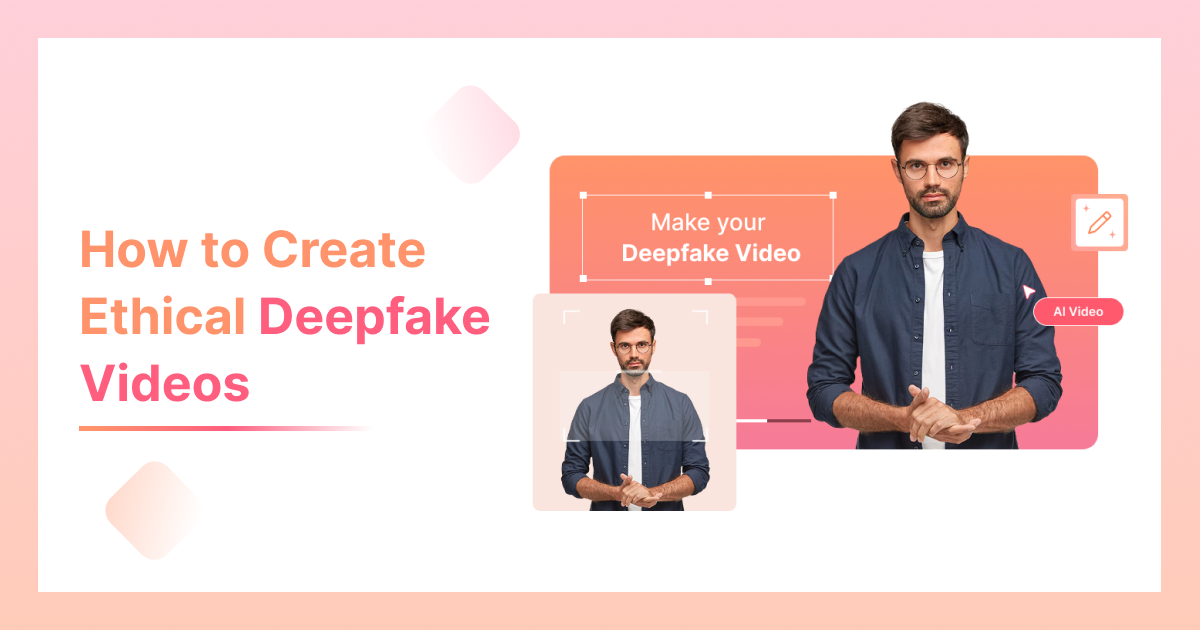Deepfake technology has emerged into the mainstream with both excellent innovation and heavy ethical issues. Employing artificial intelligence (AI), particularly deep learning models, authors can create videos or photos that replicate a person’s likeness—voice, facial expression, gestures, and even words. Although some consider deepfakes tools of deception, they can be utilized ethically for entertainment, education, marketing, and accessibility.
If you’re an educator, marketer, content creator, or coder interested in tapping into deepfake technology without pushing moral boundaries, this guidebook is your map. We’ll explain what deepfakes are, how they’re produced, and, most importantly, how to create them ethically and legally.
What Are Deepfake Videos or Pictures?
Deepfakes are synthetic media that utilize AI to realistically change or imitate a person’s face or voice. They typically involve swapping one person’s face with another in a video or creating new material based on real individuals. The level of realism produced by these methods can be mind-boggling.
Deepfakes Have A Wide Range Of Uses
- Film: Aging actors bring back down or bring historical figures back to life.
- Advertising: Producing localized content without the need to reshoot.
- Education: Simulating historical reenactments or role-playing scenarios.
- Accessibility: Assisting speech-impaired individuals through voice cloning.
But this same power has been weaponized for misinformation, defamation, and privacy breaches.
Technology Behind Deepfakes

Deepfakes rely on advanced AI, specifically neural networks such as Generative Adversarial Networks (GANs) and autoencoders. Here’s a step-by-step breakdown of how deepfakes are made:
1. Data Collection
Gather large datasets of the subject’s face and voice from multiple angles and expressions. The more diverse the data, the better the AI’s output.
2. Model Training
Train deep learning models (GANs, autoencoders, or transformers) on this data. GANs, in particular, use two neural networks—a generator and a discriminator—that compete to improve realism.
3. Synthesis
Having been trained, the model generates new content, frequently frame-by-frame, that combines original content with computer-generated facial overlays or voice modifications.
4. Post-Processing
Refining the output—correcting lip-sync mistakes, merging lighting and shadows, and improving video/audio quality.
The most popular tools are:
- DeepFaceLab
- FaceSwap
- Avatarify
- Adobe Sensei-powered AI editing tools
Why Ethics Are Important When Creating Deepfakes
As deepfakes become more realistic, so does the potential for abuse. Ethical deepfake creation isn’t only advisable—it’s paramount.
Key Ethical Issues
- Misinformation: Creating speeches or interviews for political or social effect.
- Defamation: Misrepresenting individuals in compromising or false positions.
- Loss of Trust: Getting individuals to doubt all they see online.
- Privacy Violation: Applying an individual’s likeness without permission, even when the intention is good.
Responsible deepfake usage revolves around consent, context, and openness. This is in the sense of labeling synthetic content, obtaining permissions, and clarifying what the work is for.
How to Create Ethical Deepfake Videos – Step-by-Step Guide
1. Establish a Clear, Positive Purpose
Begin by establishing your purpose. What is your deepfake for?
Educational content (e.g., a history reenactment)?
Is it a satirical parody (labeled openly)?
Artistic storytelling or creative work? Stop immediately if the aim is to lie, manipulate, or mislead.
2. Obtain Explicit Consent
Consent is absolute. Individuals should always give written, documented consent to use their face or voice for projects. This means using family, friends, or clients.
For public figures:
Use content under public domain, Creative Commons, or fair use legislation.
Avoid defamation, particularly if the material is sensitive or controversial.
3. Select Reliable Tools
Steer clear of dubious platforms or black-box tools. Instead, use well-documented, proven software:
- DeepFaceLab: Open-source and used extensively in research and film.
- FaceSwap: Community-led and transparent.
- Avatarify: Suitable for live applications.
- Adobe AI Tools: Suitable for commercial use.
Steer clear of platforms with pre-trained celebrity models—these tend to breach privacy and likeness rights.
4. Be Open with Your Audience
Transparency leads to trust. Here’s why:
Use on-screen text or intros/outros declaring that the video contains AI-generated content.
Add #AIgenerated, #deepfake, or similar tags.
Display behind-the-scenes footage or a “making-of” montage.
5. Focus on Quality and Ethical Framing
A low-effort deepfake is bound to be misunderstood. Invest in quality:
Insist on correct lip-syncing.
Synchronize lighting and camera work.
Shun contents that are bound to be quoted out of context.
Deploy captions or a narration to drive your message in humor or tutorial-based videos.
6. Steer Away from High-Risk and Dangerous Content
Steer clear of these:
Political spoofs
Suggestive or adult material
Hate content or targeted taunting
Medicinal or juridical authority impersonations
If there’s even an iota of ambiguity, do not post.
7. Perform an Ethics Test With an Off-the-Record Audience
Before making it public:
Show your video to 5–10 varying individuals.
Query: Is it clear in purpose? Is it misleading or maybe dangerous?
Modify accordingly.
8. Check for Legal Compliance
This is essential, particularly if your deepfake has commercial or viral appeal. Keep in mind:
Intellectual Property Legislation
Avoid using copyrighted material (e.g., music, logos, or movie clips) without permission.
Right to Publicity
Most nations safeguard their ownership of their image. Even in the case of parody, seek legal advice.
Defamation Laws
If your content wrongly depicts someone in a harmful manner, you might be sued.
Regional Deepfake Laws
Laws differ by country and state. For instance, certain U.S. states penalize malicious political deepfakes or non-consensual adult deepfakes.
For professional legal and AI ethics guidance, visit iBoon Technologies, a responsible AI development pioneer.
Best Practices for Distributing Ethical Deepfake Content
Distribution is where ethical lines can get fuzzy. Follow these guidelines:
Clearly Label All Content
- Always notify your viewers
- Use overlays: “This video contains AI-generated visuals.”
- Hashtags: #AIgenerated, #DeepfakeContent
- Metadata tags: Identify files in YouTube/Vimeo settings.
Distribute via Trusted Platforms
- Steer clear of forums or dodgy platforms that promote anonymity or hate content. Use:
- YouTube
- Vimeo
- Your own branded channels or sites
Built-in Safeguards
- If you’re publishing tools or templates:
- Include watermarks.
- Limit resolution to deter misuse.
- Include “ethical use” language in your license agreements.
Monitor Community Feedback
- Stay involved. If your content is being used or misinterpreted
- Address it publicly.
- Clarify your intent.
- Remove or lock down if need be.
Ethical Deepfakes in the Real World: Case Studies
Netflix’s De-Aging of Robert De Niro in “The Irishman”: Used with full actor permission and technical openness.
David Beckham’s UN Anti-Malaria Campaign: Employed deepfakes to portray him speaking in several languages.
Medical Applications
Voice cloning assists post-stroke patients or post-operative patients by replicating speech.
These use cases demonstrate how, when responsibly made, deepfakes can benefit humanity positively.
The Future of Responsible Deepfakes
- As regulations emerge and detection capabilities improve, expect:
- Forced AI tags on social media sites.
- AI detects software integrated into content engines.
- Ethical approval programs for creators of AI.
- Increased cooperation between platforms and creators towards responsible usage.
- Education will be crucial—guiding future creators through ethics from the beginning.
Conclusion
Deepfake technology offers a fantastic opportunity and a significant ethical challenge. As technologists, marketers, and content creators, we should not forget that the ability to duplicate human likeness with AI comes with integrity, transparency, and permission. When employed ethically—with good intent, correct permissions, and transparent communication—deepfakes can enrich storytelling, advance education, and enable more accessibility to content. However, abuse can swiftly undermine public confidence and create genuine damage. So, we must be vigilant about legal norms, give preference to transparency towards audiences, and continuously check how our work impacts society. Only by adopting these values will we make deep fakes a force for imagination and progress, not deceit.







